Carbonates: Siderite
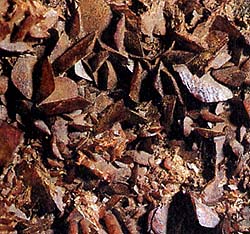 Diagnostic card.
Diagnostic card.
In the photo: lentil-shaped brown siderite. Below: zonal siderite associated with quartz from Uiel-Modin, Cornwall Peninsula (Great Britain).
Fe CO 3
The trigonial trigonometric system
Hardness 4-4,5
Specific weight 3,7-3,9
Cleavage is perfect
Broken or unclear fracture
Color from light yellow to black
Color in powder white
Glitter glass, pearl

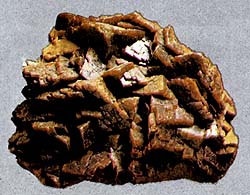 Siderite (iron spar) is iron carbonate. Glitter glass, mother-of-pearl; Shines through to transparent. Colors from honey-yellow to dark-brown. The line is white, the weathered mineral is brown. The fracture is step-uneven, less often conchoidal. Cleavage is perfect - crystals (trigonal syngony) have the shape of rhombohedra. Aggregates are fine-grained, dense. Siderite veins are of hydrothermal origin. In sedimentary carbonate sequences, siderite forms reservoir deposits, sometimes with an admixture of coal and clay. Deposits: Siegerland (North Rhine-Westphalia, Germany), Eisenerz (Austria), as well as in England, the USA, the CIS.
Siderite (iron spar) is iron carbonate. Glitter glass, mother-of-pearl; Shines through to transparent. Colors from honey-yellow to dark-brown. The line is white, the weathered mineral is brown. The fracture is step-uneven, less often conchoidal. Cleavage is perfect - crystals (trigonal syngony) have the shape of rhombohedra. Aggregates are fine-grained, dense. Siderite veins are of hydrothermal origin. In sedimentary carbonate sequences, siderite forms reservoir deposits, sometimes with an admixture of coal and clay. Deposits: Siegerland (North Rhine-Westphalia, Germany), Eisenerz (Austria), as well as in England, the USA, the CIS.
Siderite crystallizes in the trigonal system. Its crystals are not very common. Usually these are simple rhombohedra, sometimes with curved faces; Occasionally, crystals of a prismatic appearance or a skeleton are found. Shpatovidnye masses, as well as concretionary, granular or globular and kidney-shaped formations, are quite common. The color varies from pale yellow to brown and almost black in strongly manganese varieties. Siderite shines or is transparent; Shine - glass to pearl. It is fairly solid and heavy, has good cleavage in the rhombohedron, is fragile, has a conchoidal or faint fracture.
Chemical composition. Ferric oxide (FeO) 62.1% (Fe 48.3%), carbon dioxide (CO2) 37.9%, impurities MnCO3, CaCO3 and MgCO3 are often present. The shape of the crystals. Flattened rhombohedra; The crystal faces are lentically curved. Crystal structure. It is similar to the structure of calcite. Class of symmetry. Dittrigonal-skalenohedral - Zm. Cleavage. Perfect for the rhombohedron (1011). Aggregates. Dense, granular, continuous masses, also radiant formations, spherulites (spherosiderite, clay siderite).
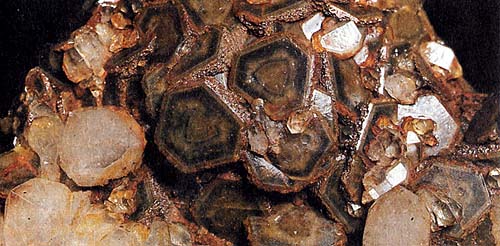 Crystals are usually simple rhombohedra, with saddle-shaped curvature of the faces, spar coarse- or fine-grained aggregates are more common: spherical or kidney-shaped radial structures; Dense, clay-mixed clusters (clayey iron ore). Cleavage is perfect along the edges of the rhombohedron; Density of 3.7-3.9; The color is yellowish-white, light yellow, gray, tan, bluish-black, black due to the impurity of coal, sometimes with metallic mottled turgance.
Crystals are usually simple rhombohedra, with saddle-shaped curvature of the faces, spar coarse- or fine-grained aggregates are more common: spherical or kidney-shaped radial structures; Dense, clay-mixed clusters (clayey iron ore). Cleavage is perfect along the edges of the rhombohedron; Density of 3.7-3.9; The color is yellowish-white, light yellow, gray, tan, bluish-black, black due to the impurity of coal, sometimes with metallic mottled turgance.
Easily eroded to limonite (pseudomorphs of limonite in siderite). It effervesces with the action of hot hydrochloric acid.
Diagnostic signs.
The mineral dissolves only in hydrochloric acid when heated with active effervescence. This makes it possible to distinguish it from brown calcite, which is readily soluble in dilute acids and in the cold. Does not melt, becomes fissured, turns brown and turns black (due to oxidation of iron). Behavior in acids. Intensively dissolves in warmed hydrochloric acid.
Origin.
Siderite is a common mineral that occurs in a variety of geological conditions. It can form significant clusters suitable for industrial mining. It can also be found in low- and medium-temperature hydrothermal ore veins, as well as in various metamorphic and magmatic rocks.
Place of Birth.
Deposits of industrial importance (mainly worked up) are located in Bergamasco and Bresciano. Beautiful crystals come from the Brosso and Traversella mines, the Canaves (Turin province), the Frigido mine (Massa Carrara province) and a number of Sardinian mines, in particular Nurra (Sassari province). The most famous are deposits of siderite Panashkire (Portugal); Eisenerz in Styria and Huttenberg in the land of Carinthia (Austria); Pribram in Bohemia (Czech Republic); Müzen near the town of Siegen, Westphalia (Germany); Tevistok in Devonshire, Cambron-Redruth on the Cornwall Peninsula (Great Britain). Famous are also fine sparrow masses in the cryolite deposit Ivigtut in Greenland and fine crystals from Mont-Saint-Hilaire, province of Quebec (Canada).
It always forms in places without access to oxygen. 1. Pelagic origin in veins is rare (Greenland). 2. A classic example is the veins of iron feldspar Siegerland in the Rhine Shale Mountains (Germany) with layers up to 30 m thick; Other deposits in Germany (Harz), Austria (Styria, Carinthia), Spain, Slovakia, Russia (South Ural); Beautiful crystals were found in Harz (Germany) and Cornwall (England). 3. Lumpy sedimentary siderites are known in England (Wales), Westphalia and Thuringia (Germany), France. As a by-product of weathering in the oxidation zone, various manganese oxides are formed because of its high content (up to 6%).
Application.
Siderite is widely used in ferrous metallurgy. It is mined primarily for the smelting of steel. The old name of siderite - spar iron ore reflects the features of the mineral. From ancient times until today, siderite is mined as a very important iron ore.
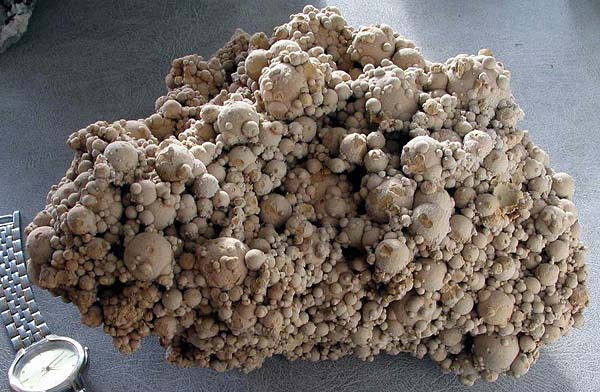
Siderite. Dalnegorsk, Primorye, Russia. Photo: © А.А. Evseev.

Siderite. Dalnegorsk, Primorye, the Russian Federation. Photo: © А.А. Evseev.
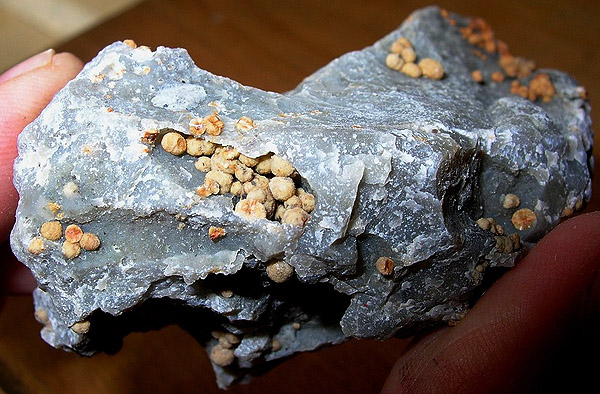
Siderite (spherical crystals). Birkachan deposit, Magadan region, Russia, CIS. Photo: © А.С. Klepikov.
- Ghetchellit - "New Almaden blend" - arsenide and antimony sulfide (modern sulfosol)
- Antimony is a toxic metal (semimetal) , widely used in metallurgy, medicine and engineering
- Zirconium - a rare and undiscovered metal and the most dangerous precious stone in oxide and salt
- Gold - yellow dangerous and poisonous metal of modern accurate digital and cable technologies
- Sulfur is a golden-yellow toxic substance and a sign of active volcanic activity
- Cadmium is an undisputed toxic silvery metal unknown to a wide range of people
- Lead - a poisonous gray imitator of metallic silver and toxic metal blende
- Arsenic is a classic poison of medieval and modern poisoners and medicine in medicine
Poisonous and radioactive dangerous stones and minerals
** - poisonous stones and minerals (mandatory check in the chemical laboratory + explicit indication of toxicity)
** - radioactive stones and minerals (mandatory check on the standard dosimeter + ban on open sales in case of radioactivity exceeding 24 milli / g / h + additional measures of population protection)
Catalog of minerals and semi-precious stones of the world by groups
** - poisonous stones and minerals
** - radioactive stones and minerals


Comments
When commenting on, remember that the content and tone of your message can hurt the feelings of real people, show respect and tolerance to your interlocutors even if you do not share their opinion, your behavior in the conditions of freedom of expression and anonymity provided by the Internet, changes Not only virtual, but also the real world. All comments are hidden from the index, spam is controlled.